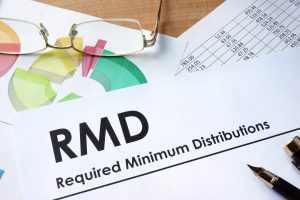Tax Planning Tips For Retirees
Tax planning is a ubiquitous part of all aspects of financial planning, and retirement is no exception. Most retirement plans will be comprised of income from Social Security, 401(k)s/IRAs, and funds from other assets and investment accounts.
 However, although there is some commonality there, everyone will have different income levels, life expectancy, and varying income needs in retirement. Retirees can use several different tax planning strategies to minimize the amount of taxes they owe, regardless of their situation.
However, although there is some commonality there, everyone will have different income levels, life expectancy, and varying income needs in retirement. Retirees can use several different tax planning strategies to minimize the amount of taxes they owe, regardless of their situation.
If you are unsure where to begin or how to strategize your taxes in retirement, this guide will help clarify how to structure your assets and income in retirement effectively so you pay the least amount possible to Uncle Sam.
As financial advisors in Greenville, SC, we strive to help all our clients structure their income and assets with an emphasis on tax minimization as possible in a way that helps them meet their financial and retirement goals.
Make Tax Moves Now that Benefit You in the Future
Planning ahead is a requirement for anyone who wants to implement an effective tax strategy. When you were investing in your retirement accounts, you didn’t base your asset allocations on short-term thinking. You likely planned decades in advance.
Tax planning is the same. Since you will always have to pay taxes, you need to be proactive in formulating effective strategies to minimize your taxable income. Here is a quick list of things you can do in the present that will pay off in the future:
- Create a realistic budget for what you think you’ll need in retirement
- Ensure that your retirement and investment income can support your lifestyle in retirement
- Know if you will be in a higher or lower tax bracket in retirement so you can strategize appropriately
- Research what your required minimum distributions (RMDs) will be
- Consider a Roth conversion or backdoor Roth if you don’t already have one; remember that you need to plan at least five years in advance from when you think you’ll need to withdraw funds
- Consider tax strategies like tax-loss harvesting for your investment accounts in retirement
These are all important steps to take as early as possible to ensure that your tax planning strategy is as efficient as possible in retirement.
Ways to Reduce Your Taxable Income
 Understanding the tax rules for retirees and retirement accounts is imperative for retirees to understand so they can make the appropriate decisions to reduce their tax bills. Here are a few ways that retirees can reduce their tax obligations in retirement:
Understanding the tax rules for retirees and retirement accounts is imperative for retirees to understand so they can make the appropriate decisions to reduce their tax bills. Here are a few ways that retirees can reduce their tax obligations in retirement:
- Invest in Roth accounts
- Consider a Roth conversion if you have a 401(k) or traditional IRA
- Consider moving to a tax-friendlier state for retirement
- Make strategic withdrawals based on your tax bracket
- Choose tax-free investments like treasury and municipal bonds
- Make longer-term investments, as the capital gains tax rate is much lower if you hold them for a year and a day
Beware of the Alternative Minimum Tax (AMT)
The alternative minimum tax (AMT) sets a floor on the percentage of taxes you must pay, regardless of the total amount of deductions or credits you claim, which can be a pain.
There is currently an AMT for certain taxpayers who earn above specific amounts of income. AMT calculations are done according to a separate set of rules in order to calculate your taxable income after deductions.
The AMT ensures that certain taxpayers under specific criteria pay their appropriate share of taxes or at least a minimum amount. The exemption for 2023 is $81,300 for single filers and $126,500 for married couples filing jointly.
Over 72, Don’t Forget Your RMDs (Required Minimum Distributions)
 Retirees who want to avoid hefty RMD penalties need to understand the RMD rules. An RMD, or required minimum distribution, is the amount of funds you must withdraw from a retirement account like a 401(k) or traditional IRA once they hit a certain age.
Retirees who want to avoid hefty RMD penalties need to understand the RMD rules. An RMD, or required minimum distribution, is the amount of funds you must withdraw from a retirement account like a 401(k) or traditional IRA once they hit a certain age.
For 2023, the age was raised to 73. Once retirees hit this age, they must begin withdrawing from their retirement account by April 1st of the year following the year they turn 73. Retirees must then withdraw the RMD amount for each subsequent year based on the current RMD calculation.
RMDs are determined by dividing the retirement account’s previous year-end fair market value against a life expectancy factor, which is published by the IRS. You are allowed to take more than the required amount, and if you own multiple IRAs, as the account holder, you will need to calculate whatever the RMD is for each separate account. However, you may be able to withdraw your total annual RMD amount from just one of your accounts.
In 2019, the SECURE Act switched up the distribution rules for inherited IRAs. It eliminated the “stretch IRA,” which was an oft-used estate planning strategy used by retirees who wanted to extend the tax-deferral benefits of their IRAs.
If you reach age 73 and elect not to take your RMD, you will incur a penalty from the IRS. The amount you did not withdraw will be subject to a 25% tax.
In a Low Tax Bracket? Pick Up Capital Gains
If you are in a lower tax bracket, then taking advantage of the lower capital gains tax rate on your investments would be a wise tax strategy for a retiree. Depending on your income, your capital gains tax rate could be as low as 8% if you plan on holding your investment long-term.
Investors who are in the 15% federal tax bracket can be eligible for a capital gains tax of 8%, assuming that they hold the investment for longer than five years.
High Earners: Pay Attention to the Medicare Surtax / Net Investment Income Tax
The Net Investment Income Tax, or NIIT (also called the Medicare Surtax), is a dreaded tax that often surprises people when it’s time to pay the tax bill.
 Retirees may owe an additional 3.8% in taxes they did not account for. This tax will only be owed if both your investment income as well as your modified adjusted gross income (MAGI) surpass a specific amount.
Retirees may owe an additional 3.8% in taxes they did not account for. This tax will only be owed if both your investment income as well as your modified adjusted gross income (MAGI) surpass a specific amount.
Both your short and long-term capital gains, dividends, all rental income, and income from passive investments count towards your net investment income. Your wages (if you decide to work in retirement), Social Security, and income from retirement accounts do not count towards your net investment income.
The IRS uses the following thresholds to determine if your MAGI surpasses the threshold:
- $200,000 for single individuals
- $250,000 for married individuals filing jointly
- $125,000 for married individuals filing separately
If your income exceeds the MAGI threshold set by the IRS, you will have to pay the additional 3.8% tax on your net investment income or on the amount that exceeds the threshold, whichever is less.
Though most financial professionals and CFPs don’t offer many solutions, if any at all, for how to avoid this extra tax, the professionals at Global View are held to a high fiduciary standard. As financial advisors in Greenville, SC, we provide all of our clients with the necessary tax planning strategies for any financial situation they may encounter before or after retirement.
65 or Older? Consider Claiming the Higher Standard Deduction
Each year, you will have a choice to claim either the standard deduction or claiming itemized deductions when you file your tax return. You will, of course, want to choose the one which serves you the most and the lion’s share of the time, claiming the standard deduction makes the most sense.
How much your standard deduction is worth will be dependent on a multitude of factors, including your filing status, age, if you are a dependent on someone else’s tax return, and if you are blind. Your standard deduction is also adjusted annually for inflation, so each year should be larger than the previous year.
For retirees at least 65 years old, you can claim an additional standard deduction worth up to $1,500 for the 2023 tax year. This amount is increased to $1,850 if you claim you are single or head of household.
If you are both 65 or older as well as blind, this additional deduction is also doubled.
Do You Know How Your Social Security Benefits Are Taxed In Retirement?
Social Security income has been subject to taxation since 1983, given that certain income limits have been surpassed. There have been no adjustments for inflation since then, so the vast majority of Americans receiving Social Security payments and also have other sources of retirement income will end up paying some taxes on their benefits.
 Regardless of income, no one receiving Social Security payments will pay taxes on their entire payment. Depending on your income, you could pay tax on 0%, 50%, or 85% of your Social Security benefits.
Regardless of income, no one receiving Social Security payments will pay taxes on their entire payment. Depending on your income, you could pay tax on 0%, 50%, or 85% of your Social Security benefits.
For individuals with a total gross income (Provisional Income) of at least $25,000, which includes part of your Social Security, or couples who file jointly and have a combined gross income of at least $32,000, up to 50% of their Social Security benefit will be taxed.
For individuals with a total gross income (including part of Social Security) of at least $34,000 or a couple who file jointly and have a combined gross income of at least $44,000, up to 85% of their Social Security benefit will be taxed.
For retirees with little income besides their Social Security payment, their benefits will typically not be taxed at all.
Structuring Taxes in Retirement
Tax planning can be difficult to structure with all of the different moving parts and income coming from different retirement and investment accounts. However, it doesn’t have to be hard to come up with a comprehensive tax plan as a retiree.
As fiduciary investment advisors serving clients in the Carolinas, the professionals at Global View are held to a high fiduciary standard and put a strong emphasis on their advisor-client relationships. Contact us today to talk with one of our advisors and see how we can help with your tax plan.





